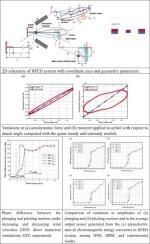一种高效的新型混合颤振风能收集器的开发及其延迟特性和滞后行为的识别-Ⅱ:理论建模、分析和仿真
IF 8.9
1区 工程技术
Q1 ENGINEERING, MECHANICAL
引用次数: 0
摘要
第二部分,本文介绍了一种新型高效混合颤振风能采集器的理论建模、分析和仿真。理论研究的重点是结构动力学、弹性恢复力的建模和非定常气动响应的公式。建立了一个三自由度的离散结构模型来描述翼型的俯冲和俯仰运动。将非线性磁弹簧与使用时滞算子构建的非线性气动模型相结合,得到一组耦合的、自治的多时滞非线性微分方程。该模型成功地捕获了系统的不稳定性和迟滞现象,包括跳跃行为。通过一系列广泛的有限元计算,我们得到了气动力和力矩在风速下的非线性表达式。将扩展的Hamilton原理与气动模型相结合,导出了结构模型,得到了完整的时滞微分方程组。在确定最佳结构并验证其参数后,解决DDEs以及相关的相位(或时间)延迟效应和特征值问题,以评估系统的稳定性并预测其动态响应-包括伴随跳跃现象的滞后行为-和能量收集性能。模型预测结果与实验结果吻合较好,验证了模型框架的准确性和可靠性。本文章由计算机程序翻译,如有差异,请以英文原文为准。

Development of an efficient, novel hybrid flutter-based wind energy harvester and identification of its delay characteristics and hysteretic behavior—Part Ⅱ: Theoretical modeling, analysis, and simulations
The second of two parts, this paper presents the theoretical modeling, analysis, and simulation of a novel, efficient hybrid flutter-based wind energy harvester. The theoretical examinations focus on structural dynamics, the modeling of the elastic restoring force, and the formulation of unsteady aerodynamic responses. A three-degree-of-freedom discrete structural model is developed to describe the plunging and pitching motions of the airfoil. The nonlinear magnetic spring is combined with a nonlinear aerodynamic model constructed using time-delay operators, which yields a set of coupled, autonomous nonlinear differential equations with multiple time delays. The model successfully captures the system’s instability and hysteresis phenomena, including jump behaviors. Through a series of extensive finite-element computations, we develop nonlinear expressions for the aerodynamic forces and moments in terms of wind velocity. The structural model is derived by combining the extended Hamilton’s principle with the aerodynamic model to obtain a complete system of delay differential equations (DDEs). After identifying the optimal configuration and validating its parameters, the DDEs, along with the associated phase (or time)-delay effects and eigenvalue problem, are solved to evaluate the system’s stability and predict its dynamic response—including the hysteretic behavior accompanying the jump phenomena—and energy-harvesting performance. The model’s predictions agree closely with the experimental results, which confirms the accuracy and reliability of the proposed modeling framework.
求助全文
通过发布文献求助,成功后即可免费获取论文全文。
去求助
来源期刊

Mechanical Systems and Signal Processing
工程技术-工程:机械
CiteScore
14.80
自引率
13.10%
发文量
1183
审稿时长
5.4 months
期刊介绍:
Journal Name: Mechanical Systems and Signal Processing (MSSP)
Interdisciplinary Focus:
Mechanical, Aerospace, and Civil Engineering
Purpose:Reporting scientific advancements of the highest quality
Arising from new techniques in sensing, instrumentation, signal processing, modelling, and control of dynamic systems
 求助内容:
求助内容: 应助结果提醒方式:
应助结果提醒方式:


